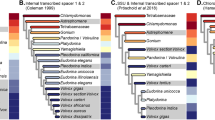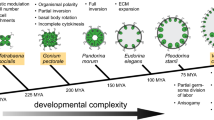Abstract
The multicellular green alga Volvox carteri forma nagariensis has only two cell types: terminally differentiated somatic cells and reproductive cells. The regA gene maintains the terminally differentiated state of the somatic cells, apparently by repressing transcription of genes required for chloroplast biogenesis and thereby preventing cell growth. Because the RegA protein sequence bore no obvious motifs, we are attempting to identify regions of functional importance by searching for strongly conserved domains in RegA orthologs. Here we report the cloning and characterization of regA from the most closely related known taxon, V. carteri f. kawasakiensis. Given the closeness of the relationship between these two formas, their regA genes are surprisingly different: they differ in the number of introns and by several lengthy indels, and they encode proteins that are only 80% identical. We also serendipitously discovered a paralogous gene immediately upstream of each regA locus. The two regA genes, both upstream paralogs and several genes in Chlamydomonas (the closest unicellular relative of Volvox) encode a conserved region (the VARL domain) that contains what appears to be a DNA-binding SAND domain. This discovery has opened up a new avenue for exploring how regA and the terminally differentiated state that it controls evolved.





Similar content being viewed by others
References
Bottomley MJ, Collard MW, Huggenvik JI, Liu Z, Gibson TJ, Sattler M (2001) The SAND domain structure defines a novel DNA-binding fold in transcriptional regulation. Nat Struct Biol 8:626–633
Brendel V, Bucher P, Nourbakhsh IR, Blaisdell BE, Karlin S (1992) Methods and algorithms for statistical analysis of protein sequences. Proc Natl Acad Sci USA 89:2002–2006
Caburet S, Cocquet J, Vaiman D, Veitia RA (2005) Coding repeats and evolutionary agility. Bioessays 27:581–587
Carles CC, Choffnes-Inada D, Reville K, Lertpiriyapong K, Fletcher JC (2005) ULTRAPETALA1 encodes a SAND domain putative transcriptional regulator that controls shoot and floral meristem activity in Arabidopsis. Development 132:897–911
Cheng Q, Fowler R, Tam LW, Edwards L, Miller SM (2003) The role of GlsA in the evolution of asymmetric cell division in the green alga Volvox carteri. Dev Genes Evol 213:328–335
Chenna R, et al (2003) Multiple sequence alignment with the Clustal series of programs. Nucleic Acids Res 31:3497–3500
Coleman AW (1999) Phylogenetic analysis of Volvocacae for comparative genetic studies. Proc Natl Acad Sci USA 96:13892–13897
Comeron JM (1999) K-Estimator: calculation of the number of nucleotide substitutions per site and the confidence intervals. Bioinformatics 15:763–764
Duncan L, Bouckaert K, Yeh F, Kirk DL (2002) kangaroo, a mobile element from Volvox carteri, is a member of a newly recognized third class of retrotransposons. Genetics 162:1617–1630
Fabry S, Jacobsen A, Huber H, Palme K, Schmitt R (1993) Structure, expression, and phylogenetic relationships of a family of ypt genes encoding small G-proteins in the green alga Volvox carteri. Curr Genet 24:229–240
Ferris PJ, Pavlovic C, Fabry S, Goodenough UW (1997) Rapid evolution of sex-related genes in Chlamydomonas. Proc Natl Acad Sci USA 94:8634–8639
Hall B (2004) Phylogenetic trees made easy: a how-to manual. 2nd edn. Sinauer Associates, Inc., Sunderland, MA
Harper JF, Huson KS, Kirk DL (1987) Use of repetitive sequences to identify DNA polymorphisms linked to regA, a developmentally important locus in Volvox. Genes Dev 1:573–584
Harper JF, Mages W (1988) Organization and structure of Volvox beta-tubulin genes. Mol Gen Genet 213:315–324
Huskey RJ, Griffin BE (1979) Genetic control of somatic cell differentiation in Volvox. Analysis of somatic regenerator mutants. Dev Biol 72:226–235
Karlin S, Brocchieri L, Bergman A, Mrazek J, Gentles AJ (2002) Amino acid runs in eukaryotic proteomes and disease associations. Proc Natl Acad Sci USA 99:333–338
Kirk D (1998) Volvox: molecular-genetic origins of multicellularity and cellular differentiation. Cambridge University Press, Cambridge
Kirk DL (1999) Evolution of multicellularity in the volvocine algae. Curr Opin Plant Biol 2:496–501
Kirk DL (2005) A twelve-step program for evolving multicellularity and a division of labor. Bioessays 27:299–310
Kirk DL, Kirk MM (1983) Protein synthetic patterns during the asexual life cycle of Volvox carteri. Dev Biol 96:493–506
Kirk MM, Kirk DL (1985) Translational regulation of protein synthesis, in response to light, at a critical stage of Volvox development. Cell 41:419–428
Kirk MM, et al (1999) regA, a Volvox gene that plays a central role in germ-soma differentiation, encodes a novel regulatory protein. Development 126:639–647
Kropat J, von Gromoff ED, Muller FW, Beck CF (1995) Heat shock and light activation of a Chlamydomonas HSP70 gene are mediated by independent regulatory pathways. Mol Gen Genet 248:727–734
Li WH, Wu CI, Luo CC (1985) A new method for estimating synonymous and nonsynonymous rates of nucleotide substitution considering the relative likelihood of nucleotide and codon changes. Mol Biol Evol 2:150–174
Liss M, Kirk DL, Beyser K, Fabry S (1997) Intron sequences provide a tool for high-resolution phylogenetic analysis of volvocine algae. Curr Genet 31:214–227
Meissner M, Stark K, Cresnar B, Kirk DL, Schmitt R (1999) Volvox germline-specific genes that are putative targets of RegA repression encode chloroplast proteins. Curr Genet 36:363–370
Miller SM, Kirk DL (1999) glsA, a Volvox gene required for asymmetric division and germ cell specification, encodes a chaperone-like protein. Development 126:649–658
Nishii I, Ogihara S, Kirk DL (2003) A kinesin, invA, plays an essential role in Volvox morphogenesis. Cell 113:743–753
Nozaki H (1988) Morphology, sexual reproduction and taxonomy of Volvox carteri f. kawasakiensis f. nov. (Chlorophyta) from Japan. Phycologia 27:209–220
Nozaki H (2003) Origin and evolution of the genera Pleodorina and Volvox (Volvocales). Biologia (Bratislava) 58:425–431
Sambrook J, Fritsch EF, Maniatis T (1989) Molecular cloning: a laboratory manual. Cold Spring Harbor Press, Cold Spring Harbor, NY
Stark K, Kirk DL, Schmitt R (2001) Two enhancers and one silencer located in the introns of regA control somatic cell differentiation in Volvox carteri. Genes Dev 15:1449–1460
Starr RC (1969) Structure, reproduction and differentiation in Volvox carteri f. nagariensis IYENGAR, strains HK9 and HK10. Arch Protistenkd 111:204–222
Starr RC (1970) Control of differentiation in Volvox. Symp Soc Dev Biol 29:59–100
Surdo PL, Bottomley MJ, Sattler M, Scheffzek K (2003) Crystal structure and nuclear magnetic resonance analyses of the SAND domain from glucocorticoid modulatory element binding protein-1 reveals deoxyribonucleic acid and zinc binding regions. Mol Endocrinol 17:1283–1295
Acknowledgments
We thank Jennifer Brisson, Christina Tuskey, Kristine Bouckaert and Stephanie Buckley for valuable help in various stages of this project and Greg Robertson for helpful comments, and Hisayoshi Nozaki for providing us with a culture of f. kawasakiensis. LD was a Jane Coffin Childs Post-Doctoral Fellow. Support to AH was provided by an NIGMS Initiative for Minority Student Development Grant (R25-GM55036) and Procter and Gamble. This work was supported by grants IBN-9904739 and IBN-0131565 from the National Science Foundation to DLK and grant IBN-0077535 from the National Science Foundation to SMM.
Author information
Authors and Affiliations
Corresponding author
Additional information
Communicated by F.-A. Wollman
Nucleotide sequence data reported here are available in the DDBJ/EMBL/GenBank databases under the accession numbers DQ247963 & AF106962
Rights and permissions
About this article
Cite this article
Duncan, L., Nishii, I., Howard, A. et al. Orthologs and paralogs of regA, a master cell-type regulatory gene in Volvox carteri . Curr Genet 50, 61–72 (2006). https://doi.org/10.1007/s00294-006-0071-4
Received:
Revised:
Accepted:
Published:
Issue Date:
DOI: https://doi.org/10.1007/s00294-006-0071-4




